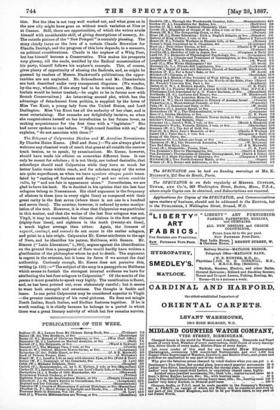The Eclogues of Calpurnius Siculus and If. Aurelius Nemesianus. By
Charles Heine Keene. (Bell and Sons.)—We are always glad to welcome any classical work of merit that goes at all outside the narrow track beaten, so to speak, by examinations. Mr. Keene, however, should have made his edition on somewhat different lines. It can only be meant for scholars ; it is not likely, nor indeed desirable, that schoolboys should read Calpurnius while they have so muoh far better Latin verse within reach, and for scholars many of the notes are quite superfluous, as when we have squalors situque posito trans- lated by "casting off foulness and decay 1" and nee so/um eandida matu, by " and not fair in appearance alone." Nevertheless, we are glad to have his book. He is decided in his opinion that the last four eclogues belong to Nemesianus. His chief argument is the frequency of elisione in them (one in every eight lines) as compared with their great rarity in the first seven (where there is not one in a hundred and seven lines). The number, however, is reduced by some manipu- lation of the text. However, it is clear that Calpurnius was particular in this matter, and that the writer of the last four colognes was not. Virgil, it may be remarked, has thirteen elisions in the first eclogue (eighty-four lines), and eighteen in the tenth (twenty-six lines), a much higher average than either. Again, the licenses of expectO, contingd, and concedo do not occur in the earlier eclogues, and point to a late origin. Calpurnius Mr. Keene attributes to the age of Nero, and he identifies his patron, Melibssue, with Seneca. Mr. Simoox (" Latin Literature," i., 380), argues against the identification on the ground that a panegyrist of Nero would hardly have written a glorification of the philosopher whom be put to death. The argument is cogent in the extreme, but it loses its force if we accept the dual authorship. Curiously enough, Mr. Keene does not perceive this, writing (p.156) :—" The subject of the song is a panegyric on Melibmus which seems to furnish the strongest internal evidence we have for attributing the last four eclogues to Calpurnius." Of the merits of the poems it is not possible to speak very highly. The versification is fluent, and, as has been pointed out, even elaborately careful ; but it seems to want both strength and sweetness. The thought is feeble and inane. In one point Calpurnius may be considered superior to Virgil, —the greater consistency of his rural pictures. He does not mingle North Italian, South Italian, and Sicilian features together. If he is worth reading, it is chiefly because lie belongs to a period in which there was a great literary activity of which hat few remains survive.


































 Previous page
Previous page